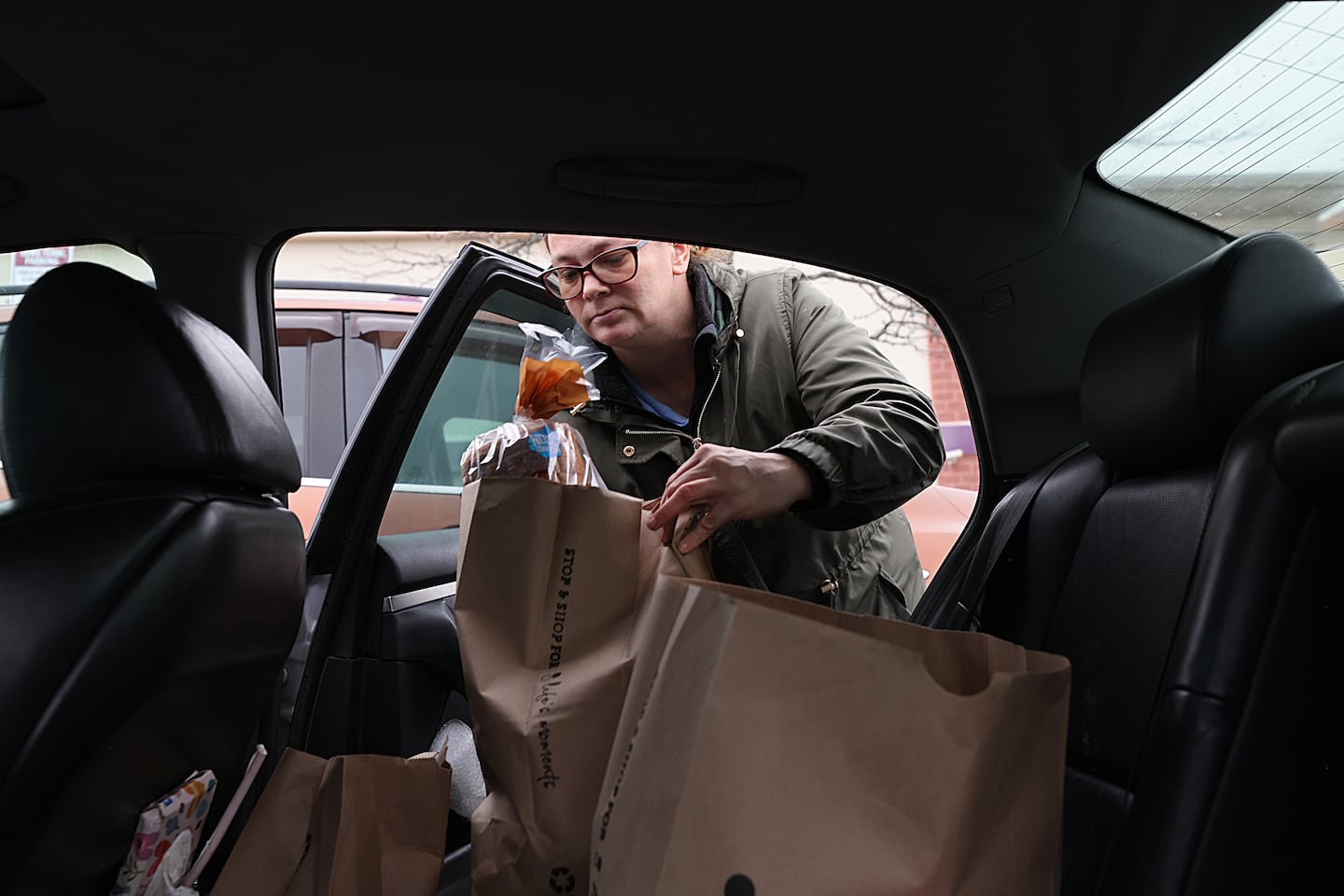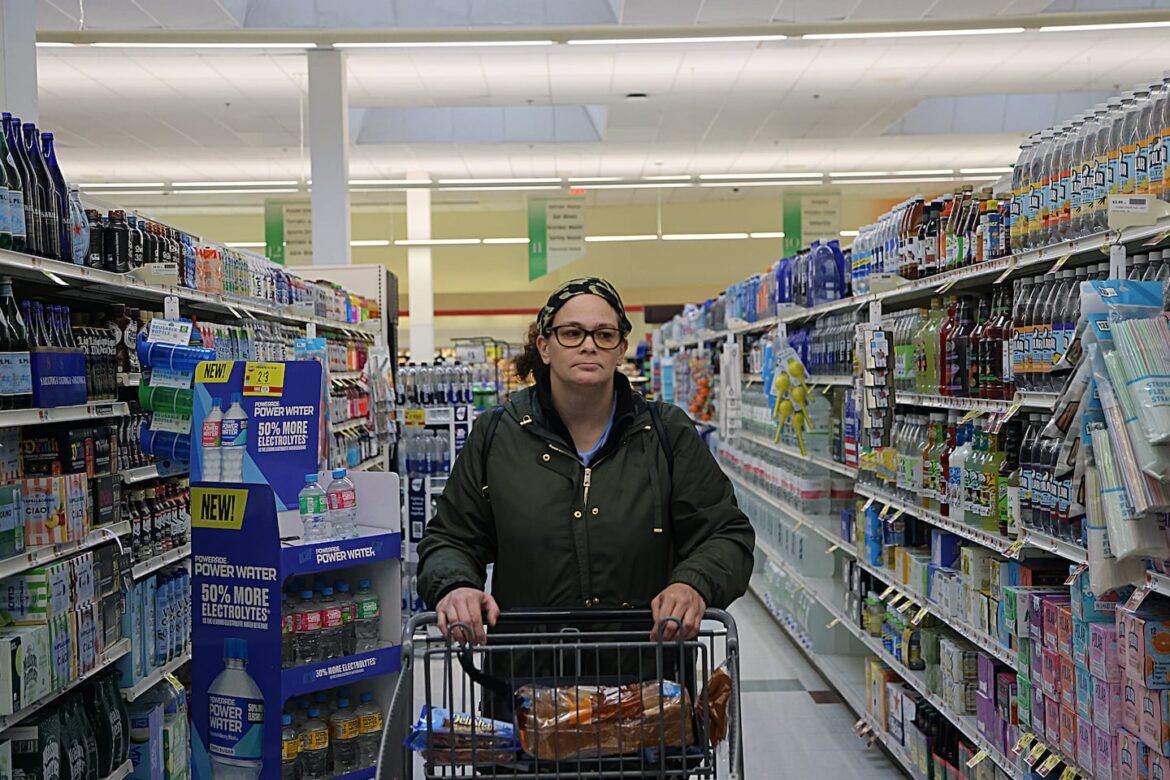Dingman receives $50 a month in food assistance from the federal government, through the Supplemental Nutrition Assistance Program, or SNAP. By the time the US Department of Agriculture announced that SNAP benefits for November would not be released because of the government shutdown, that $50 from the previous month was long gone.
 Dingman put groceries in her car. Suzanne Kreiter/Globe Staff
Dingman put groceries in her car. Suzanne Kreiter/Globe Staff
Although the record-breaking government shutdown that disrupted food aid to low-income and disabled people ended Wednesday the crisis it spawned underscored an uncomfortable reality: that tens of millions of people in the US are frequently in danger of going hungry. The effort many undertake to find food, even with public assistance, is akin to a part-time job, one that exacts a considerable emotional toll. Millions of Americans regularly wrestle with the anxiety of deciding which bills to put off, which meal to skip, which small indulgence to allow.
“As wretched as this has been, I hope this shows that we have to do a lot more to tackle food insecurity here,” said Liz O’Gilvie, who heads two anti-hunger organizations in the city.
More than 1 million people in Massachusetts receive food stamps. But an even larger number are food insecure — 1 out of every 3 residents has limited or uncertain access to sufficient food. And Hampden County, where Springfield is located, has the highest percentage of SNAP recipients in the state, with some 30 percent of the city’s residents living in poverty.
On the first Wednesday in November, Dingman dropped Jamari off at school with a hug and an “I love you,” and then headed to the Big Y grocery store: a bag of clementines ($2.99), cereal ($2.99), a pack of Gatorade ($14.99), chips ($5), several cans of pasta ($1.59 each), a few packages of instant Ramen ($.33 each), and cheese sticks ($3.50). Total: $49.99, equivalent to her entire monthly SNAP. She still needed fruit, so she later stopped by the Stop & Shop for two containers of melon, a slice of strawberry shortcake, and some beef jerky: $30.69.
Dingman next headed to a farm store run by Gardening the Community, a local food nonprofit that was giving out milk and eggs for free since SNAP benefits were not dispersed. By Tuesday, Nov. 3, there was a line out the door.
There, she took advantage of a Massachusetts program that allows any recipient with at least one cent on their SNAP accounts to receive $40 for fresh produce from participating farms. Dingman picked up two apples, a bag of potatoes, bananas, two lemons, an onion, and a single radish: $9.88, leaving $30 for the rest of the month.
 Dingman added items to her cart.Suzanne Kreiter/Globe Staff
Dingman added items to her cart.Suzanne Kreiter/Globe Staff
As she packed the produce, an elderly man with long white hair and beard, wearing black knee-high socks and a bike helmet bounced through the door. Charlie Knight is 80, or “20 times four.” He and Dingman shared details on local meetings about food insecurity that were scheduled for later that week. There was one at Way Finders the next day, a local housing nonprofit. Dinner would be served first; Dingman advised Knight to go early.
He planned to. Knight receives $289 in SNAP benefits that typically come on the 13th of each month. This month, if it comes through, he’ll use most of it to buy food for others who have even less than he does.
He planned to eat one meal a day at a soup kitchen, getting by in between on Skippy reduced fat peanut butter — Super Chunky, which Knight says “lasts a little longer.”
Knight also planned to rely on friends such as Diana Grau-Lopez, 55. As neighbors 25 years ago, Grau-Lopez would send over a plate of food. Decades later, Knight and Grau-Lopez live farther apart, but she still calls: “Have you eaten today?”
Knight was at the farm store to grab ingredients for Grau-Lopez: $8.43 worth of potatoes and sweet potatoes, which he hoped might make a meal.
En route to her house, outside a Popeye’s advertising $6 meals, Knight picked up a discarded empty Coke can. “My neighbor collects these. $.5 a can,” he said, throwing it into his bike bag. “When I find a can, I bring it to him. When he gets extra food, he gives it. It’s how we live!” The man recently gave Knight two pints of coffee ice cream, his favorite.
Grau-Lopez, who receives around $250 a month in SNAP, would rely on Knight to find food during the shutdown. They planned to go to Martin Luther King Jr. Family Services the next day for an early morning pantry. Next, the pair would hit the farm store for free eggs and milk. And after that, Knight would help make 150 sandwiches for the soup kitchen at St. George Greek Orthodox Cathedral.
In nearby Holyoke, nearly one-quarter of residents live below the poverty line and more than 40 percent receive SNAP benefits. One of those is Orlando Rivera, now the sole caregiver to 10-year-old Daniel Librado and 12-year-old Genesis Maria after their mother died of a fentanyl overdose in 2023.
“I had to let go of the jobs I had, which required me to be out the door at five in the morning,” the 48-year-old Rivera said. ”I had to be a single dad.”
 Orlando Rivera Jr. sang happy birthday to his son, Daniel Librado Rivera, on his tenth birthday on Nov. 10 with his twelve-year-old daughter, Genesis Maria Rivera (right) in Holyoke. His neighbor donated the birthday cake.Suzanne Kreiter/Globe Staff
Orlando Rivera Jr. sang happy birthday to his son, Daniel Librado Rivera, on his tenth birthday on Nov. 10 with his twelve-year-old daughter, Genesis Maria Rivera (right) in Holyoke. His neighbor donated the birthday cake.Suzanne Kreiter/Globe Staff Daniel Librado Rivera played with his new tablet that his father got on sale for him.Suzanne Kreiter/Globe Staff
Daniel Librado Rivera played with his new tablet that his father got on sale for him.Suzanne Kreiter/Globe Staff
Rivera’s weekly schedule revolves around making the $735 a month he gets from SNAP stretch. “I cook every other day. The next day we have leftovers for breakfast or lunch. In between is cereal and sandwich day, or ramen noodle soup day.”
November is always tight. His daughter’s birthday is on the 9th, his son’s the following day, with Thanksgiving a few weeks later. Rivera hoped to buy a $25 ice cream cake to celebrate mid-month, but it wasn’t clear if his SNAP would come through on November 13 as planned. He’s skipped paying this month’s phone bill to save up in case.
“I’m penny pinching, every little thing.”
After school, Rivera and Daniel walked to Iglesia De Dios Levantando Al Caido food pantry to see what was available for a weekend of meals. Rivera mapped out a menu: pasta with tuna, rice with tuna, leftover white rice with fried egg. The food pantry also had cereal, ramen, apples and bread.
Around 4 p.m., Rivera and Daniel headed to the YMCA to pick up Genesis from an after school program. Rivera tries to keep her there as long as possible, since they provide food.
Back at their apartment, the kids aimed for a piece of leftover steak the size of Rivera’s palm. “Split it,” he said. In the fridge was a half gallon of milk, a few slices of bread, some cold cuts, condiments.
It was sandwich and cereal night. At the bodega around the corner, Rivera paid $13.37 for cereal, bread, and one aluminum sheet pan. Rivera’s receipt showed he had $4.88 left in his SNAP account, and he thought of that birthday cake. “My kids’ birthday, I always make it special. I might be late, but I always make it special.”
Back in Springfield, Renée Dingman offered to buy her son pizza for dinner. Jamari didn’t want her to spend any money, instead frying up an egg to spruce up a bowl of ramen.
Knight stopped by Way Finders for dinner. At home, he ate the last two spoonfuls of peanut butter. While going to sleep, he’ll often think of lyrics to a song he recently learned: “Draw the circle wide. Draw the circle wide. No one stands alone. We all stand side by side. Draw the circle wider still. Draw the circle wide.”
This story was produced by the Globe’s Money, Power, Inequality team, which covers the racial wealth gap in Greater Boston. You can sign up for the newsletter here.
Mara Kardas-Nelson can be reached at mara.kardas-nelson@globe.com.


Dining and Cooking